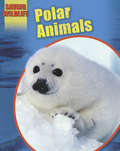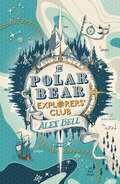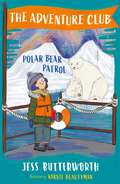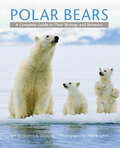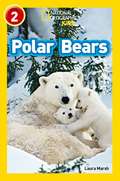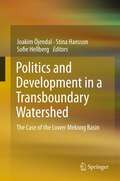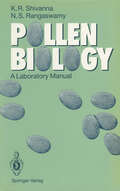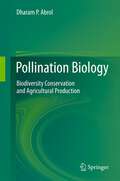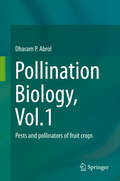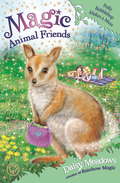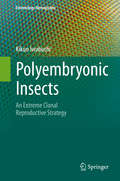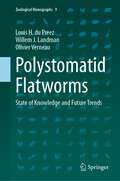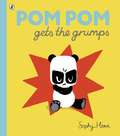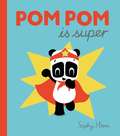- Table View
- List View
Polar Animals: Polar Animals Saving Wildlife: Polar Animals (Saving Wildlife)
by Sonya NewlandPolar Animals investigates the threats and conservation efforts focused on creatures that live on the land and in the icy waters of the world's harshest and most remote regions.It is part of the Saving Wildlife series, which investigates the world's endangered species in the context of their different environments.
The Polar Bear Explorers' Club (The Polar Bear Explorers' Club #1)
by Alex BellIt sounded like a respectable and worthy enough death for an explorer - tumbling from an ice bridge to be impaled upon a mammoth tusk - but Stella really, really didn't want that to happen, just the same.Join Stella Starflake Pearl and her three fellow explorers as they trek across the snowy Icelands and come face-to-face with frost fairies, snow queens, outlaw hideouts, unicorns, pygmy dinosaurs and carnivorous cabbages . . . When Stella and three other junior explorers get separated from their expedition can they cross the frozen wilderness and live to tell the tale?A gorgeously imaginative middle grade fantasy adventure combining the best of Peter Pan, Lemony Snicket, Northern Lights and Alice in Wonderland.'A magical adventure of friendship, bravery and derring-do in a richly imagined world.' The Bookseller'A fantastic frosty adventure.' Sunday Express'Wintry, atmospheric, highly imaginative fantasy.' Metro'The most huggable book of the year . . . An (iced) gem.' SFX
Polar Bear Patrol: Book 3 (The Adventure Club #3)
by Jess ButterworthDo you like exploring, animals and adventure? Then join The Adventure Club! A new illustrated series for younger readers about animals and adventure from much-loved author Jess Butterworth - writer of classic adventure stories in vibrantly described settings.It's time for the third Adventure Club trip, and this time Tilly and the Adventure Club are off to the Arctic circle in search of polar bears! There, they journey across the ice on sleighs pulled by huskies, camp in tents, and watch the northern lights, braving sub-zero temperatures. But on a boat trip, disaster strikes! The team find a narwhal caught in a fishing net. It's a race against time to free the narwhal. Will they succeed? And will the Adventure Club team spot a single polar bear before they have to leave?Join the Adventure Club with Tilly to find out!Packed full of illustrations and set as Tilly's own diary, this new series is perfect for young readers who are beginning to read on their own.
Polar Bears: A Complete Guide to Their Biology and Behavior (Endangered And Threatened Animals Ser.)
by Andrew E. DerocherThe polar bear, king of the Arctic, is one of the world’s most recognizable animals. Images of the majestic beasts roaming across the ice cap, plunging into frigid waters, and playing with furry cubs have come to symbolize the beauty and grandeur of the Arctic. Andrew E. Derocher and Wayne Lynch have spent decades following the bears, and this book offers the most comprehensive and readable review of their biology, ecology, behavior, and conservation.With gripping photographs by Lynch, a preeminent wildlife photographer, and the personal stories of Derocher, this book is as stunning to look at as it is fascinating to read. It weaves together their remarkable experiences with the latest research to tell the amazing story of these Arctic predators, tracing the animals back to their evolutionary roots and looking ahead to the future of polar bears on a warming planet Earth.Through informative and engaging language, Derocher carefully explains the sea ice ecosystem that is essential to the survival of polar bears. He addresses the threat of global warming to the Arctic—home to polar bears for tens of thousands of years—and describes in impressive detail their feeding habits, distribution, den ecology, and reproduction. Lynch’s vivid photographs capture all this and more as they chronicle the wide range of polar bear behavior, from family rituals to ferocious predatory practices. Captivating, accurate, and inspiring, Polar Bears belongs in the hands of all who love the wild.
Polar Bears: Level 2 (National Geographic Readers Ser.)
by Laura Marsh National Geographic Kids StaffNational Geographic Primary Readers pair magnificent National Geographic photographs with engaging text by skilled authors to help your child learn to read. Developed by education experts, this series of books for beginner readers is spread across four levels: Early Reader, Becoming Fluent, Becoming Independent and Independent Reader. With their beautiful white fur and powerful presence, polar bears rule the Arctic. In this National Geographic Kids Level 2 Reader, children will learn how these majestic giants care for their adorable cubs and why they’re threatened by global warming. Beautiful photos, fascinating facts and carefully levelled text make this book perfect for reading aloud as children become more fluent in their reading. Level 2: Becoming Fluent books are a great match for kids who are developing reading stamina and enjoy a longer book. They are ideal for readers of Green, Orange and Turquoise book bands for guided reading.
Polarized Light and Polarization Vision in Animal Sciences (Springer Series in Vision Research #2)
by Gábor HorváthThis book covers advances made since the 2004 Springer volume “Polarized Light in Animal Vision” edited by Horvath and Varju, but also provides reviews and synopses of some areas. Part I examines polarization sensitivity across many animal taxa including vertebrates and invertebrates and details both terrestrial and aquatic life. Part II is devoted to the description of polarized light in nature and explores how the physics of light must be taken into account when understanding how polarized light is detected by the visual system. This includes underwater polarization due to scattering; polarization patterns reflected from freshwater bodies; polarization characteristics of forest canopies; normal and anomalous polarization patterns of the skies; skylight polarization transmitted through Snell’s window and both linearly and circularly polarized signals produced by terrestrial and aquatic animals. This Part also examines polarized “light pollution” induced by anthropogenic factors such as reflection off asphalt surfaces, glass panes, car bodies, and other man-made structures that are now known to form ecological traps for polarotactic insects. Part III surveys some of the practical applications of polarization vision including polarization-based traps for biting insects, ground-based polarimetric cloud detectors and an historical examination of the navigational abilities of Viking seafarers using the sky polarization compass. The deterrent qualities of ungulate pelage to polarization-sensitive biting insects is also examined in this section.
Polarized Light in Animal Vision: Polarization Patterns in Nature
by Gábor Horváth Dezsö VarjuThe subject of this volume is two-fold. First, it gathers typical polarization patterns occurring in nature. Second, it surveys the polarization-sensitive ani mals, the physiological mechanisms and biological functions of polarization sensitivity as weIl as the polarization-guided behaviour in animals. The monograph is prepared for biologists, physicists and meteorologists, espe cially for experts of atmospheric optics and animal vision, who wish to under stand and reveal the message hidden in polarization patterns of the optical environment not directly accessible to the human visual system, but measur able by polarimetry and perceived by many animals. Our volume is an attempt to build a bridge between these two physical and biological flelds. In Part I we introduce the reader to the elements of imaging polarimetry. This technique can be efflciently used, e. g. in atmospheric optics, remote sens ing and biology. In Part 11 we deal with typical polarization patterns of the natural optical environment. Sunrise/sunset, clear skies, cloudy skies, moonshine and total solar eclipses all mean quite different illumination conditions, wh ich also affect the spatial distribution and strength of celestial polarization. We pre sent the polarization patterns of the sky and its unpolarized (neutral) points under sunlit, moonlit, clear, cloudy and eclipsed conditions as a function of solar elevation. The polarization pattern of a rainbow is also shown. That part of the spectrum is derived in which perception of skylight polarization is optimal under partly cloudy skies.
POLES AND GRIDWORK
by Jane WallaceThis illustrated guide provides straightforward advice on using poles and gridwork in order to improve a horse's suppleness, balance, strength and agility. It covers riding over poles, lungeing over poles, simple grids, exercises with bounces, jumping at an angle and turning exercises.
The Political Economy of Global Warming: The Terminal Crisis (Routledge Explorations in Environmental Studies)
by Del WestonHumanity is facing an unprecedented global catastrophe as a result of global warming. This book examines the reasons why international agencies, together with national governments, are seemingly unable to provide real and binding solutions to the problems. The reasons presented relate to the existing dominant global economic structure of capitalism as well as the fact that global warming is too often seen as an isolated problem rather than one of a suite of exceptional, converging and accelerating crises arising from the global capitalist political economy. This book adopts a political economy framework to address these issues. It accepts the science of global warming but challenges the predominant politics and economics of global warming. To illustrate the key issues involved, the book draws on South Africa – building on Samir Amin’s thesis that the country represents a microcosm of the global political economy. By taking a political economy approach, the book provides a clear explanation of the deep and pervasive problem of the denial which fails to acknowledge global warming as a systemic rather than a market problem. The book should be of interest to students and scholars researching climate change, environmental politics, environmental and ecological economics, development studies and political economics.
The Political Economy of Global Warming: The Terminal Crisis (Routledge Explorations in Environmental Studies)
by Del WestonHumanity is facing an unprecedented global catastrophe as a result of global warming. This book examines the reasons why international agencies, together with national governments, are seemingly unable to provide real and binding solutions to the problems. The reasons presented relate to the existing dominant global economic structure of capitalism as well as the fact that global warming is too often seen as an isolated problem rather than one of a suite of exceptional, converging and accelerating crises arising from the global capitalist political economy. This book adopts a political economy framework to address these issues. It accepts the science of global warming but challenges the predominant politics and economics of global warming. To illustrate the key issues involved, the book draws on South Africa – building on Samir Amin’s thesis that the country represents a microcosm of the global political economy. By taking a political economy approach, the book provides a clear explanation of the deep and pervasive problem of the denial which fails to acknowledge global warming as a systemic rather than a market problem. The book should be of interest to students and scholars researching climate change, environmental politics, environmental and ecological economics, development studies and political economics.
Politics and Development in a Transboundary Watershed: The Case of the Lower Mekong Basin
by Joakim Öjendal, Stina Hansson and Sofie HellbergWater - and its governance - is becoming a global concern partly because it is turning into a goods in short supply, with devastating effects on literally billions of people, but also because it is the "carrier" of global warming; whether through irregular weather patterns or through flooding, water is how global warming will be 'felt'. The lion's share of the globally available fresh water resources is to be found in transboundary systems. In spite of its significance, the generated knowledge on how to deal with transboundary waters is weak and leaves policy makers with seemingly unavoidable, trade-off dilemmas and prioritizations, often with detrimental effects. In order to disentangle this predicament this volume works with one case: the Lower Mekong Basin and covers state-of-the-art academic and practitioners' knowledge and hence appeals to a wide audience. The topic this volume addresses is situated in the nexus of an IR- (International Relations) approach focussing on transboundary politics and its inclination to remain within the sphere of state sovereignty and national interest on the one hand, and Development studies, with its imperatives on participation, planning, and intervention, on the other. The dilemma, we argue, of better understanding transboundary water management lies in how to understand how these two rationalities can be simultaneously nurtured.Audience: This book will be relevant to scholars, as it provides cutting-edge research, and students, since it covers the primary debates in the field, interested in resource management, regional politics, and development issues in the area. It also addresses the global debate on transboundary water management and presents an in-depth case of one of the globally most sophisticated attempts at pursuing sustainable river basin management. Finally, practitioners and policymakers would benefit greatly because all contributions have explicit policy relevance, launching suggestion on improvements in water management.
The Politics of Animal Experimentation
by Dan LyonsThe reality of animal experimentation and its regulation in Britain have been hidden behind a curtain of secrecy since its emergence as a political controversy in the 1870s. Public debate and political science alike have been severely hampered by a profound lack of reliable information about the practice. In this remarkable study, Dan Lyons advances and applies policy network analysis to investigate the evolution of British animal research policy-making.
Pollen Biology: A Laboratory Manual
by K.R. Shivanna N.S. RangaswamyPollen grains are everywhere - in the air, in the water, in soil and in the food we eat. Pollen has direct relevance in agriculture, horticulture, plant breeding, crop improvement and biotechnology. They are further of use for montioring cytotoxic effects - by herbicides, pesticides and pollutants - testing for allergic reactions, and for basic studies on gene expression, research on differentiation and polarity. Detailed instructions of the standard techniques, which have all been tested and improvised by the authors, are given, such as collection and storage of pollen, pollen culture, germination, tests for viability, incompatibility and isolation of protoplasts. Introduced by an explanation of the principles involved, the step-by step protocols are complemented by personal notes and precautions, specifying the reagents used and various appendices on basic and specific requirements for laboratory exercises on pollen.
Pollen Biotechnology: Gene Expression and Allergen Characterization
by Shyam S. Mohapatra R.B. KnoxThe last decade has seen tremendous progress in our knowledge of the pollen development and gene expression on one hand and the characterization of pollen specific proteins on the other. In compiling the chapters for this volume, we have pragmatically categorized these basic developments in pollen molecular biology and biotechnology into two sections based on their applications in agricul ture and implications in medicine. Pollen developmental biology and gene expression: applications in agricul ture. Pollen development is an extremely complex process encompassing a series of biochemical, physiological and genetic events. At the basic level, sporophyt ically expressed genes may expound our knowledge of unique processes of cellular differentiation which ultimately give rise to a full-fledged organism. At the applied level, the studies on the pollen and male sporophyte-specific gene expression, and of promoters and transcription factors of relevant genes have the potential to manipulate the fertility in certain cash crops leading to agricultural biotechnology.
Pollination: The Enduring Relationship between Plant and Pollinator
by Pollination Timothy WalkerAn enticing illustrated look at pollination, one of the most astonishing marvels of the natural worldPollination is essential to the survival of most plants on Earth. Some plants rely on the wind to transport pollen from one flower to another. Others employ an array of ingenious strategies to attract and exploit pollinators, whether they be insects, birds, or mammals. This beautifully illustrated book provides an unprecedented look at the wonders of pollination biology, drawing on the latest science to explain the extraordinarily complex relationship between plant and pollinator, and revealing why pollination is vital for healthy ecosystems and a healthy planet.Timothy Walker offers an engaging introduction to pollination biology and explores the many different tactics of plant reproduction. He shows how wind and water can be effective yet wildly unpredictable means of pollination, and describes the intimate interactions of pollinating plants with bees and butterflies, beetles and birds, and lizards and bats. Walker explores how plants entice pollinators using scents, colors, and shapes, and how plants rely on rewards as well as trickery to attract animals. He sheds light on the important role of pollination in ecology, evolution, and agriculture, and discusses why habitat management, species recovery programs, and other conservation efforts are more critical now than ever.Featuring hundreds of color photos and illustrations, Pollination is suitable for undergraduate study and is an essential resource for naturalists, horticulturalists, and backyard gardeners.
Pollination and Floral Ecology
by Pat WillmerPollination and Floral Ecology is the most comprehensive single-volume reference to all aspects of pollination biology--and the first fully up-to-date resource of its kind to appear in decades. This beautifully illustrated book describes how flowers use colors, shapes, and scents to advertise themselves; how they offer pollen and nectar as rewards; and how they share complex interactions with beetles, birds, bats, bees, and other creatures. The ecology of these interactions is covered in depth, including the timing and patterning of flowering, competition among flowering plants to attract certain visitors and deter others, and the many ways plants and animals can cheat each other. Pollination and Floral Ecology pays special attention to the prevalence of specialization and generalization in animal-flower interactions, and examines how a lack of distinction between casual visitors and true pollinators can produce misleading conclusions about flower evolution and animal-flower mutualism. This one-of-a-kind reference also gives insights into the vital pollination services that animals provide to crops and native flora, and sets these issues in the context of today's global pollination crisis. Provides the most up-to-date resource on pollination and floral ecology Describes flower advertising features and rewards, foraging and learning by flower-visiting animals, behaviors of generalist and specialist pollinators--and more Examines the ecology and evolution of animal-flower interactions, from the molecular to macroevolutionary scale Features hundreds of color and black-and-white illustrations
Pollination and Floral Ecology
by Pat WillmerPollination and Floral Ecology is the most comprehensive single-volume reference to all aspects of pollination biology--and the first fully up-to-date resource of its kind to appear in decades. This beautifully illustrated book describes how flowers use colors, shapes, and scents to advertise themselves; how they offer pollen and nectar as rewards; and how they share complex interactions with beetles, birds, bats, bees, and other creatures. The ecology of these interactions is covered in depth, including the timing and patterning of flowering, competition among flowering plants to attract certain visitors and deter others, and the many ways plants and animals can cheat each other. Pollination and Floral Ecology pays special attention to the prevalence of specialization and generalization in animal-flower interactions, and examines how a lack of distinction between casual visitors and true pollinators can produce misleading conclusions about flower evolution and animal-flower mutualism. This one-of-a-kind reference also gives insights into the vital pollination services that animals provide to crops and native flora, and sets these issues in the context of today's global pollination crisis. Provides the most up-to-date resource on pollination and floral ecology Describes flower advertising features and rewards, foraging and learning by flower-visiting animals, behaviors of generalist and specialist pollinators--and more Examines the ecology and evolution of animal-flower interactions, from the molecular to macroevolutionary scale Features hundreds of color and black-and-white illustrations
Pollination Biology: Biodiversity Conservation and Agricultural Production
by Dharam P. AbrolThis book has a wider approach not strictly focused on crop production compared to other books that are strictly oriented towards bees, but has a generalist approach to pollination biology. It also highlights relationships between introduced and wild pollinators and consequences of such introductions on communities of wild pollinating insects. The chapters on biochemical basis of plant-pollination interaction, pollination energetics, climate change and pollinators and pollinators as bioindicators of ecosystem functioning provide a base for future insights into pollination biology. The role of honeybees and wild bees on crop pollination, value of bee pollination, planned honeybee pollination, non-bee pollinators, safety of pollinators, pollination in cages, pollination for hybrid seed production, the problem of diseases, genetically modified plants and bees, the role of bees in improving food security and livelihoods, capacity building and awareness for pollinators are also discussed.
Pollination Biology, Vol.1: Pests and pollinators of fruit crops
by Dharam P. AbrolThe book covers interplay between pest management strategies and safety of pollinators. Detailed information is provided on pests and pollinators of temperate, subtropical and tropical fruit crops. Most of the fruit crops are highly cross pollinated and depend upon insects or benefit from insect pollination for fruit set. Insect pests on the other hand cause major economic damage on fruit crops in tropics, subtropics and temperate. Evidently, pest management in fruit crops on one hand and providing safety to the pollinators on the other is a challenging task in the context of increasing horticultural productivity without upsetting the ecological balance. This book aims to integrate and develop pest control strategies in a way to minimize their impact on beneficial insect species such as natural enemies and pollinators to enhance fruit production and quality. The book covers interplay between pest management strategies and safety of pollinators. Detailed information is provided on pests and pollinators of temperate, subtropical and tropical fruit crops. Pollinators play a crucial role in flowering plant reproduction and in the production of most fruits and vegetables. Most of the fruit crops are highly cross pollinated and depend upon insects or benefit from insect pollination for fruit set. Insect pests on the other hand cause major economic damage on fruit crops in tropics, subtropics and temperate. Evidently, pest management in fruit crops on one hand and providing safety to the pollinators on the other is a challenging task in the context of increasing horticultural productivity without upsetting the ecological balance. This book aims to integrate and develop pest control strategies in a way to minimize their impact on beneficial insect species such as natural enemies and pollinators to enhance fruit production and quality. Most of the fruit crops are highly cross pollinated and depend upon insects or benefit from insect pollination for fruit set. Insect pests on the other hand cause major economic damage on fruit crops in tropics, subtropics and temperate. Evidently, pest management in fruit crops on one hand and providing safety to the pollinators on the other is a challenging task in the context of increasing horticultural productivity without upsetting the ecological balance. This book aims to integrate and develop pest control strategies in a way to minimize their impact on beneficial insect species such as natural enemies and pollinators to enhance fruit production and quality. The book covers interplay between pest management strategies and safety of pollinators.
Polly Bobblehop Makes a Mess: Book 31 (Magic Animal Friends #31)
by Daisy MeadowsAn enchanting series full of adorable animals, magic and friendship - from the creator of RAINBOW MAGIC, the UK's bestselling series for girls aged 5-7.Lily and Jess are having a wonderful time in Friendship Forest with their magical friends - until horrible Grizelda turns up! The wicked witch unleashes wind sprites to spread havoc throughout the enchanted land. Can the girls help cuddlesome wallaby Polly Bobblehop bring peace back to her world?
Polyembryonic Insects: An Extreme Clonal Reproductive Strategy (Entomology Monographs)
by Kikuo IwabuchiThis book provides an overview of our current understanding of polyembryony in insects. The study of polyembronic insects has advanced considerably over the last several decades.The book shows the exciting potential of polyembryonic insects and their impact on life sciences. It describes the mechanisms of polyembryogenesis; tissue-compatible invasion of the host, which is the first case of compatible cellular interaction between phylogenetically distant organisms without rejection; the sex differences in defense; and the environmental regulation of caste structure. The first book devoted to polyembryony in insects, it draws on the author’s research on polyembryonic wasps from 1990 to the present day, covering various topics such as polyembryogenesis in vitro, host-parasite interaction, sex differences in soldier function/humoral toxic factor, and the transcription analysis of polyembryogenesis.It is intended not only for researchers in the field of entomology, parasitology, ontogeny, reproductive biology, developmental biology, sociobiology, and evolutionary developmental biology (Evo-Devo), but also for postgraduate students in these fields.
Polymeric Nanoparticles for Bovine Mastitis Treatment (Springer Series in Biomaterials Science and Engineering #19)
by Ali Haider Muhammad Ikram Iram Shahzadi Muhammad Asif RazaThis book features an in-depth examination of the ongoing problem of bovine mastitis and the potential solutions offered by polymer nanoparticles. With extensive research and analysis, the book delves into the causes and consequences of bovine mastitis, including the shift in the relevance of various infections and the increasing problem of antibiotic resistance. The authors explore the use of nanoparticles as a potential alternative to traditional antibiotics and the importance of tailoring their characteristics for specific uses. Detailed discussions of the pros and cons of different manufacturing procedures and characterizations of bovine mastitis, drug-resistant bacteria, and resistance development make this monograph an invaluable resource for researchers and experts in the field of veterinary medicine, and an excellent resource for those interested in investigating the viability of nano-materials as future antibiotic alternatives.
Polystomatid Flatworms: State of Knowledge and Future Trends (Zoological Monographs #9)
by Louis H. du Preez Willem J. Landman Olivier VerneauThis unique book offers a comprehensive guide to the fascinating world of polystomatid flatworms. It introduces the reader to the individual life histories of polystomes and the chronological advances in our knowledge, with descriptions of species discovered over the past centuries. It equips newcomers to the field with basic protocols and techniques for collecting, processing and interpreting material. It also presents the history of research on this group of parasites, provides information on the discovery of each polystome and acknowledges the authors that have made major contributions. For the established researcher in the field, it offers a reference book containing taxonomic data, measurements and drawings of all known polystomes. The authors have brought together all the available material, creating a resource that will stimulate research and revive the global focus on this unique group of parasites. Thus, this work provides an essential reference for both established researchers and newcomers to the field.
Pom Pom Gets the Grumps
by Sophy HennA delightful and hilarious new character from exciting new author and illustrator talent, Sophy Henn, creator of the highly acclaimed picture book, Where Bear?.When Pom Pom Panda wakes up in a BAD mood one morning, nothing is right. And then things go from bad to worse. A fresh and funny new take on toddler tantrums, that will strike a chord with parents and young children alike.
Pom Pom is Super
by Sophy HennPom Pom was excited. So excited . . . all his friends were coming round to play and he couldn't wait!And when they arrive in superhero costumes, Pom Pom thinks he might quite like to be super too. There's just one problem: Pom Pom isn't exactly sure what he's super AT.This is a sweet and funny story all about finding your talents, that will strike a chord with parents and young children alike.
